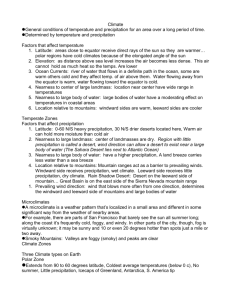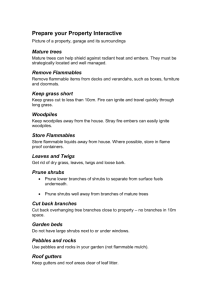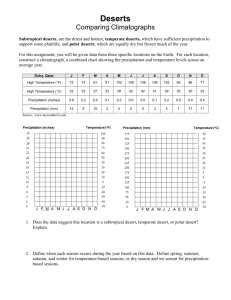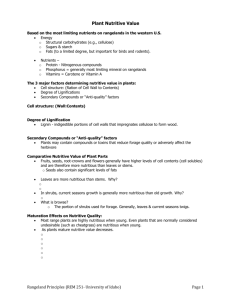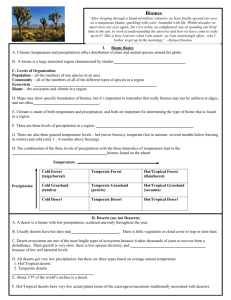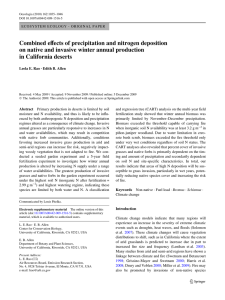lecture 11
advertisement
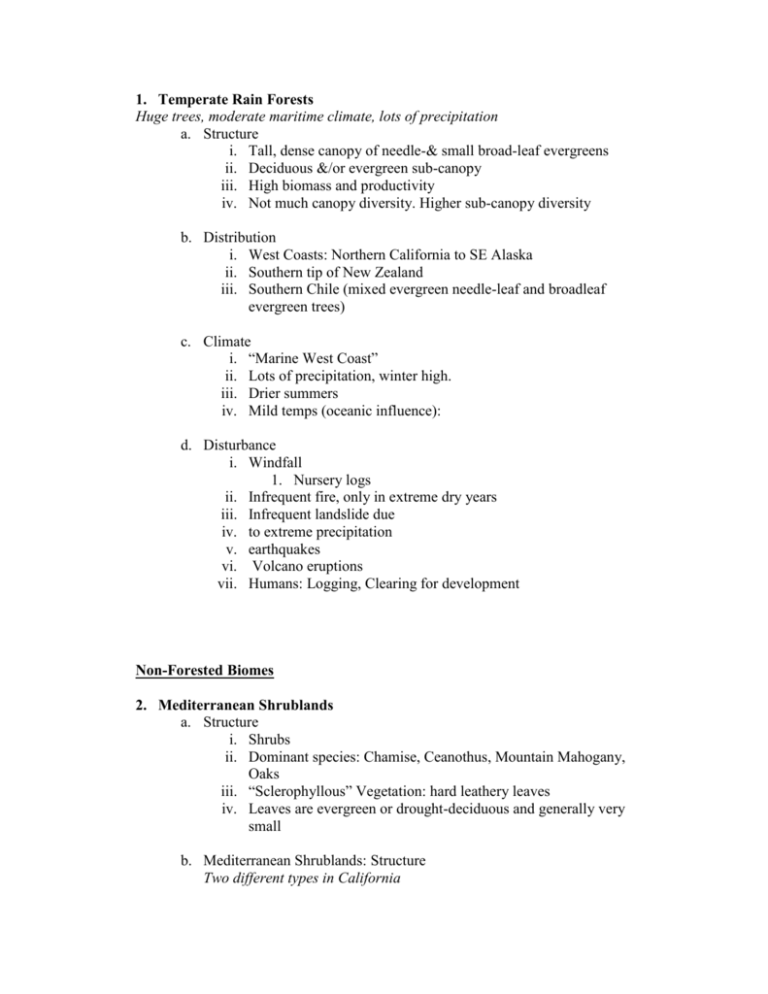
1. Temperate Rain Forests Huge trees, moderate maritime climate, lots of precipitation a. Structure i. Tall, dense canopy of needle-& small broad-leaf evergreens ii. Deciduous &/or evergreen sub-canopy iii. High biomass and productivity iv. Not much canopy diversity. Higher sub-canopy diversity b. Distribution i. West Coasts: Northern California to SE Alaska ii. Southern tip of New Zealand iii. Southern Chile (mixed evergreen needle-leaf and broadleaf evergreen trees) c. Climate i. “Marine West Coast” ii. Lots of precipitation, winter high. iii. Drier summers iv. Mild temps (oceanic influence): d. Disturbance i. Windfall 1. Nursery logs ii. Infrequent fire, only in extreme dry years iii. Infrequent landslide due iv. to extreme precipitation v. earthquakes vi. Volcano eruptions vii. Humans: Logging, Clearing for development Non-Forested Biomes 2. Mediterranean Shrublands a. Structure i. Shrubs ii. Dominant species: Chamise, Ceanothus, Mountain Mahogany, Oaks iii. “Sclerophyllous” Vegetation: hard leathery leaves iv. Leaves are evergreen or drought-deciduous and generally very small b. Mediterranean Shrublands: Structure Two different types in California i. Coastal Sage Scrub: 2-layered 1. Shrubs = 1 m tall spaced far apart 2. Lots of grasses and forbs “understory” 3. Located along the coast (low elevation) ii. Chaparral: a thick wall of shrubs 1. 2 to 5 dominant shrub species 2. Lacks much understory in mature stage 3. Located at higher elevations than C.S.S. c. Distribution i. 5 disjunct locations located on west coasts of continents between 30-40 degrees latitude 1. Southern California: Chaparral, C.S.S. 2. South America (Chile): Matorral 3. Australia: Heath 4. South Africa: Fynbos 5. Mediterranean Sea: Maquis or Matorral d. Climate i. Winter high in precipitation ii. Definite summer drought iii. Temperatures mild in winter, mild to hot in summer iv. Similar patterns to Temperate Rain Forest e. Disturbance i. Landslides, Floods ii. Fire is very important! iii. Frequent fires iv. Re-sprouting shrubs (quick return interval) v. “Fire Followers” vi. Human disturbances: clearing for development, changing fire regime (suppression vs acceleration) 3. Deserts Characterized by very low precipitation a. Warm deserts i. Lower latitudes, warmer temperatures ii. Subtropical High Pressure Zones iii. Moderately Complex Structure iv. Shrub layer v. Annual grasses and forbs (after rains) vi. “Tree” layer: Saguaro cacti, Joshua Trees vii. Moderate biodiversity viii. Low productivity, low biomass b. Cold deserts i. Cold Winters, Warm Summers ii. Rainshadow Deserts iii. Low diversity, productivity, and biomass iv. Lacks a “tree” layer v. Few cacti vi. Dominated by shrubs and grasses c. Case studies of North American Deserts i. Chihuahuan Desert 1. Warm Desert 2. Yuccas, Creosote Bush 3. Summer high precipitation (Monsoon) 4. Texas, New Mexico, Northern Mexico ii. Sonoran Desert 1. Warm Desert 2. Arizona, California, Northern Mexico 3. Two precipitation highs 4. High biodiversity 5. Lots of large cacti a. Saguaros b. Organ pipe cactus iii. Mojave Desert 1. Warm/Cold Desert 2. Southeastern California, Southern Nevada, Northwestern Arizona 3. Creosote Bush 4. Joshua Trees 5. Winter high Precip. iv. Great Basin Desert 1. Cold, rainshadow desert 2. Winter high precip. 3. Sagebrush, Rabbitbrush, Greasewood 4. Eastern Oregon, Nevada, Utah, parts of Idaho and Wyoming v. Disturbances 1. Wind and water erosion 2. Flooding during rain events 3. Not much fire historically 4. Human a. Off road vehicles b. c. d. e. Changes in fire regime Grazing Mining Exotic species: Cheat Grass i. Invasive exotic species ii. Grows between shrubs iii. Highly flammable iv. Shrubs burn, don’t come back v. Cheat Grass thrives with fire vi. Sagebrush shrubland Cheat grass vii. A “positive feedback” 4. Temperate Grasslands a. Tallgrass vs. Shortgrass: A precipitation gradient b. Tall Grass Prairie i. Grasses and Forbs ii. Historically maintained by fire (2-4 year interval) iii. Without fire, may become a deciduous forest iv. Moderate to low biomass, but high productivity v. Best soils in the world (Mollisols) vi. Dominated by agriculture c. Short Grass Prairie i. Dominated by short grasses, forbs and shrubs ii. Drier than Tall Grass Prairie iii. Less fire because less fuel iv. Soils productive, not as rich as tall grass v. Biomass and productivity fairly low vi. Grazing and agriculture (irrigation needed)

